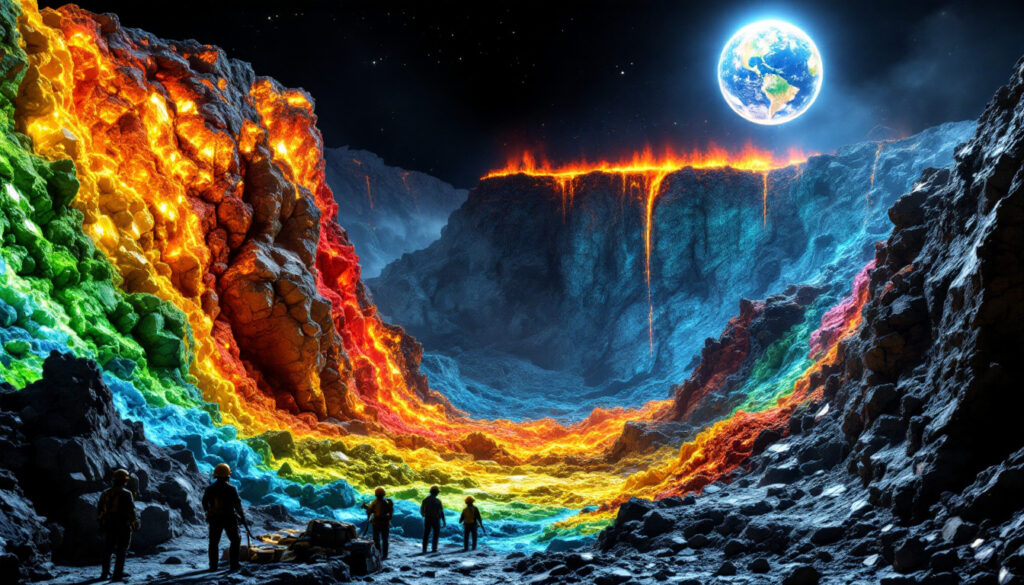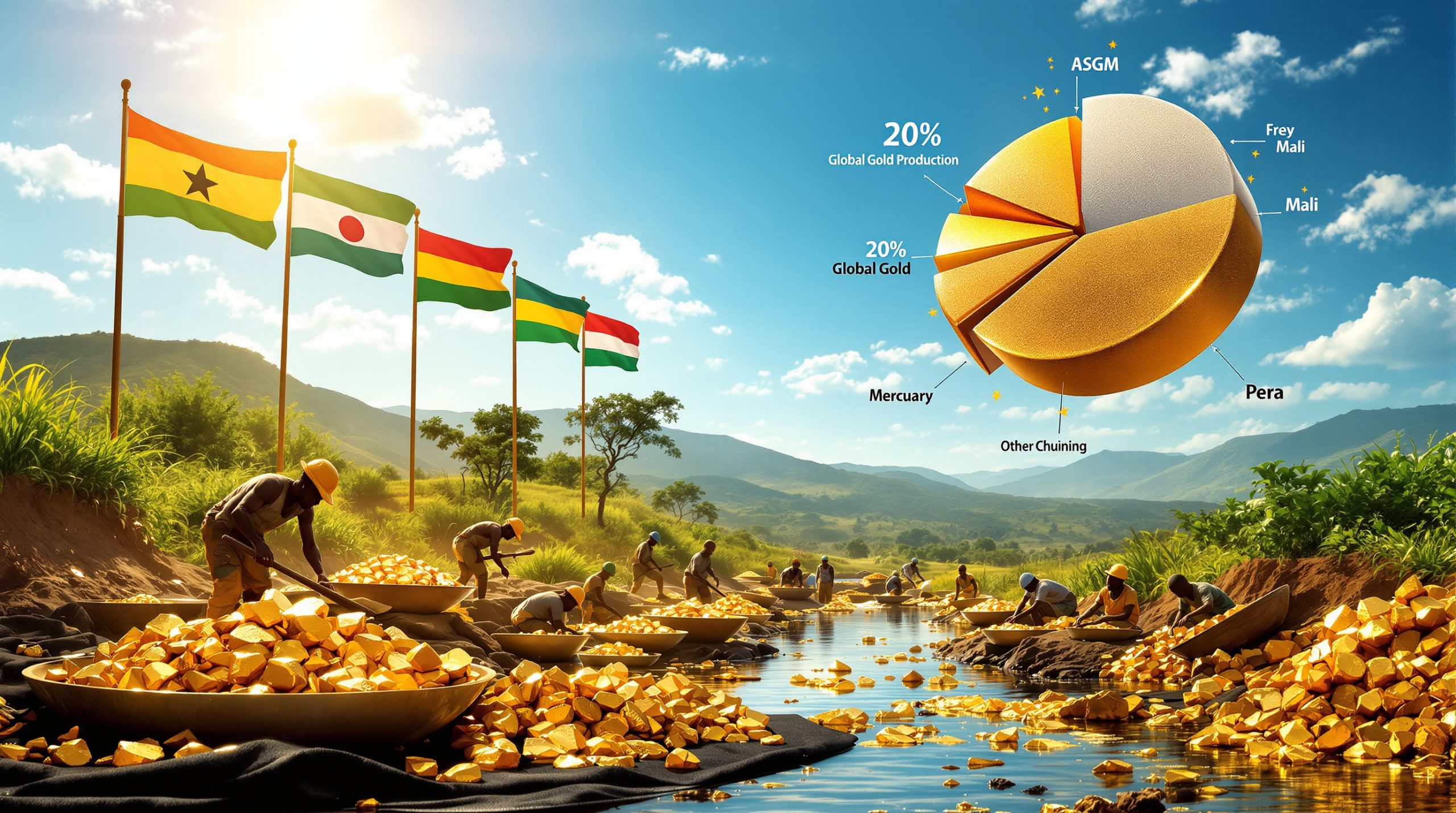What Are Skarns and Why Do They Matter in Metal Mining?
Skarns represent some of the most versatile and valuable deposit types in the mining industry, yet they remain less familiar to many investors compared to other geological formations. These unique mineral systems form through complex chemical interactions and host an impressive diversity of economically significant metals that are crucial to both traditional industries and emerging technologies.
The economic impact of skarn deposits is substantial. In British Columbia alone, there are 735 recorded skarn occurrences, which have historically contributed approximately 90% of the province's iron production, 80% of its tungsten, and 12% of its copper. These deposits have yielded impressive quantities of precious metals as well, including 119 tonnes of gold and 364 tonnes of silver from BC skarn mines.
"Skarns are associated with iron, copper, gold, tungsten, lead, zinc, molybdenum, and rarely tin mineralization, forming through metasomatic processes," according to minerals researchers G.E. Ray and I.C.L Webster, highlighting the remarkable versatility of these deposit types.
What makes skarns particularly valuable is their tendency to concentrate multiple metals in relatively small volumes, often at higher grades than other deposit types. This creates opportunities for targeted, high-margin mining operations that can remain profitable even during challenging market conditions.
Understanding Skarn Formation
Skarns develop through metasomatic processes—essentially the chemical transformation of rocks through fluid interaction. When magma intrudes into or near carbonate rocks like limestone, the heat and mineral-rich fluids from the cooling magma alter the surrounding rock, creating distinctive calcium-rich silicate minerals like garnet and pyroxene.
According to mining geologist Lawrence Meinhart, skarns develop as "zoned systems in space and time, similar to porphyry and IOCG deposits," with different minerals forming in concentric patterns around the intrusive contact. This zonation can help explorers target the most valuable parts of the deposit.
The formation process typically occurs at relatively shallow depths in the earth's crust, where magmatic fluids can interact efficiently with surrounding rocks. This interaction is most intense at the direct contact between intrusive rocks and carbonates, but can extend outward for considerable distances, creating large alteration haloes.
How Are Skarns Formed?
Skarn formation represents one of geology's most fascinating chemical transformations. The process begins when magma intrudes into carbonate-rich sedimentary rocks, triggering a complex sequence of mineral replacement and recrystallization. The heat from the intrusion creates a thermal gradient, while magmatic fluids rich in silicon, aluminum, iron, and other elements infiltrate the surrounding rocks.
In British Columbia, research has identified three major periods of skarn formation: the Jurassic (372 occurrences), Cretaceous (120 occurrences), and Eocene-Oligocene (61 occurrences). The BC Geological Survey notes that skarn formation coincided with "subduction-related plutonism," linking these deposits to major tectonic events.
"The chemical transformation of rocks through fluid interaction," as described by geologist A.H. Lang, creates distinctive mineral assemblages that vary with distance from the intrusive contact. These assemblages serve as important exploration indicators, helping geologists identify potential ore zones.
Key Characteristics That Make Skarns Valuable
Several distinctive characteristics make skarn deposits particularly valuable for mining:
- Zoned mineral assemblages that allow geologists to vector toward high-grade zones
- Multiple metal potential with combinations of base, precious, and specialty metals
- High-grade concentrations in relatively compact volumes
- Recognizable alteration minerals that facilitate exploration
- Proximity to intrusive bodies that may host other deposit types
The irregular geometry of skarns presents both challenges and opportunities. While this complexity makes systematic mining difficult, it also means that small, high-grade pods can be selectively extracted, potentially yielding exceptional returns with minimal capital investment.
Examples like the Buckhorn Mountain mine in Washington State and Golfo de Oro in Mexico showcase the multi-metal zonation patterns that can develop within these systems, with different metals concentrated in distinct parts of the deposit.
Which Metals Are Found in Skarn Deposits?
Skarns host an impressive diversity of economically important metals, making them versatile targets for mining companies. The specific metal assemblages vary depending on the age, geological setting, and composition of both the intrusive rocks and the host carbonates.
British Columbia's skarn deposits alone have produced approximately 35 million tonnes of iron concentrate, 850,000 tonnes of copper metal, 7,520 tonnes of tungsten concentrate, and 1,760 tonnes of molybdenum concentrate. The economic significance of these figures is substantial, representing major contributions to regional metal production.
"Iron, copper, gold, and tungsten are primary skarn commodities," notes geologist A.H. Lang, highlighting the most common economic targets. However, many skarn deposits contain multiple metals, improving their overall economic viability.
Primary Economic Metals in Skarns
The principal metals extracted from skarn deposits worldwide include:
- Iron: Typically as magnetite in exoskarn zones, sometimes with grades exceeding 60%
- Copper: Often associated with gold in calcic skarns related to dioritic to granodioritic intrusions
- Gold: Found in both proximal and distal skarn zones, sometimes at spectacular grades
- Tungsten: Predominantly as scheelite in Cretaceous skarns, especially those related to granitic intrusions
- Lead and zinc: More common in distal skarn zones and magnesian skarns
- Molybdenum: Generally associated with deeper, higher-temperature zones
- Silver: Often accompanying lead-zinc mineralization
- Tin: Rarer, but significant in certain regions globally
The metal distribution within skarns is not random but follows predictable patterns based on temperature gradients, fluid chemistry, and host rock composition. This predictability, once understood for a specific deposit, can guide efficient exploration and extraction.
Notable examples include the Fortitude mine in Nevada for copper-gold skarn mineralization and the massive Ok Tedi operation in Papua New Guinea, which has produced significant quantities of copper and gold from skarn ore.
Where Are Major Skarn Deposits Located Globally?
Skarn deposits follow distinct global distribution patterns that reflect the geology of ore deposits necessary for their formation. They're predominantly concentrated around the Pacific Ring of Fire, corresponding to zones of active or recent subduction and associated magmatism.
In British Columbia alone, 112 skarn deposits have been significant producers throughout mining history. The Pacific Ring distribution extends from Alaska southward through western North America to Peru, and on the western side, from Korea, Japan, and Russia through Southeast Asia to Australia.
"Skarn distribution aligns with carbonate-rich sedimentary basins," explains researcher G.E. Ray, highlighting the importance of suitable host rocks in addition to magmatic activity.
Notable Skarn Mining Operations
Several world-class mines have been developed on skarn deposits, including:
- Tasu and Nickel Plate in British Columbia, significant producers of iron and gold respectively
- Buckhorn Mountain in Washington State, which yielded high-grade gold until its recent closure
- Fortitude and McCoy in Nevada, important copper-gold producers
- Golfo de Oro in Mexico, known for polymetallic production
- Ok Tedi in Papua New Guinea, a major copper-gold operation
- Madison Mine in Montana, currently under option to Rio Tinto
While the Pacific Rim hosts the majority of important skarn deposits, notable exceptions exist elsewhere, including the Gaspe copper skarns in Quebec and various deposits in eastern Canada. These "outlier" skarns often form in areas where carbonate rocks have been intruded by plutons unrelated to subduction zones.
The global distribution pattern of skarns makes them important contributors to mineral economies in diverse regions, from North America to Asia and beyond. Their widespread occurrence ensures that they'll continue to play a significant role in global metal production.
How Did Geological Time Periods Influence Skarn Formation?
The formation of skarn deposits is not distributed evenly through geological time but occurs in distinct episodes linked to major tectonic and magmatic events. In British Columbia, three principal periods of skarn formation have been identified, each with distinctive characteristics and metal associations.
Jurassic-period skarns (201-164 million years ago) dominate the landscape, accounting for more than 50% of all skarn occurrences in BC. These deposits formed during a time of significant subduction-related magmatism along the western margin of North America and are responsible for most of the province's iron, copper, gold, and molybdenum skarn production.
The BC Geological Survey notes that "Eocene-Oligocene skarns are smaller but significant," especially for certain metal types that formed under different conditions than their older counterparts.
Jurassic Period Skarns (201-164 million years ago)
This prolific period of skarn formation created the foundation for British Columbia's mining industry with deposits characterized by:
- Predominant iron-copper-gold-molybdenum associations
- Formation related to island arc plutonism
- Generally larger size compared to younger skarns
- Examples include many of the Texada Island iron skarns
The Early to Middle Jurassic represents the single most important episode for skarn formation in western North America, coinciding with active subduction and the accretion of terrane fragments to the continental margin.
Cretaceous and Tertiary Period Developments
The Cretaceous Period (145-66 million years ago) produced a different suite of skarn deposits, including:
- Virtually all tungsten and tin skarns in British Columbia
- Numerous lead-zinc skarn deposits
- Generally smaller but often higher-grade deposits
- Formation related to more evolved, granitic magmatism
These younger skarns reflect changing tectonic conditions and magma compositions through time. The specialization in tungsten during the Cretaceous, for instance, relates to the more differentiated nature of the intrusions compared to the earlier Jurassic period.
The Eocene-Oligocene epochs (56-23 million years ago) produced the youngest significant skarns in the region, often with polymetallic signatures and complex mineralogy. These younger deposits formed during a period of post-subduction extension and are sometimes associated with epithermal mineralization styles.
This temporal evolution of skarn formation demonstrates how changing tectonic settings influence the types of metals concentrated, providing a valuable framework for exploration targeting based on regional geological history.
What Challenges Do Mining Companies Face with Skarn Deposits?
Despite their mineral wealth, skarns present unique challenges that have historically limited their development compared to more straightforward deposit types. These challenges require specialized approaches to exploration, resource definition, and mining.
Skarn orebodies typically constitute less than 10% of the total altered envelope, making the identification of economically viable zones complicated. The Madison Mine in Montana, for example, required phased drilling campaigns to properly delineate its high-grade zones before attracting interest from major mining company Rio Tinto.
"Irregular geometry complicates resource estimation," according to researcher G.E. Ray, highlighting one of the fundamental challenges in skarn mining. The discontinuous nature of high-grade pods can make systematic mine planning difficult and increase the risk of dilution during extraction.
Exploration and Definition Difficulties
Mining companies face several specific challenges when exploring skarn systems:
- Complex internal structure requiring detailed drilling to define accurately
- Irregular boundaries that don't follow predictable patterns
- Variable metal distribution even within visually similar rock types
- Potential for structural offsets that displace mineralized zones
- Difficulty distinguishing ore from waste in some skarn assemblages
These factors combine to make skarn exploration more intensive per ton of resource defined compared to larger, more homogeneous deposit types like porphyries. However, modern technologies are helping address these challenges.
According to mining geologist Lawrence Meinhart, "Metallurgical complexity demands tailored processing" for skarn ores. The variable mineralogy can result in changing recovery rates across a deposit, requiring careful blending strategies or specialized processing circuits to maintain consistent metal recovery.
Examples like Nevada's McCoy mine have demonstrated success using geochemical vectoring for exploration, analyzing mineral composition changes to guide drilling toward high-grade zones. Similarly, the historic Nickel Plate Mine in British Columbia tackled ore variability through selective mining techniques that focused on visual identification of gold-bearing zones.
The challenges of skarn mining, while significant, are increasingly being overcome through advanced mineral exploration strategies improved processing methods, and more sophisticated mining approaches. This evolution is making previously marginal skarn deposits economically viable in today's market.
How Do Small-Scale Operations Benefit from Skarn Deposits?
The very characteristics that make skarns challenging for large mining companies often create ideal conditions for smaller operators. Their typically high grades, relatively small footprints, and potential for selective mining make them attractive targets for junior mining companies and mid-tier producers looking for high-margin opportunities.
British Columbia's production of 119 tonnes of gold from skarns has largely come from operations that would be considered small by modern standards, yet they were highly profitable due to exceptional grades. Today's junior companies often target skarn deposits under 5 million tonnes but with gold grades exceeding 5 grams per tonne, creating viable operations even at modest production rates.
"Skarns offer juniors opportunities overlooked by majors," notes industry expert Ellsworth Dickson, highlighting how their smaller size often places them below the threshold of interest for major mining companies that need to replace large reserves.
Advantages for Junior Mining Companies
Small-scale operators benefit from several aspects of skarn deposits:
- High-grade zones that can be selectively mined with modest equipment
- Relatively low capital requirements compared to large porphyry or sediment-hosted deposits
- Potential for direct shipping ore in some cases (particularly magnetite)
- Shorter development timelines from discovery to production
- Lower environmental footprint due to smaller disturbance area
Modern modular processing plants have further enhanced the viability of small-scale skarn operations, allowing companies to begin production with minimal upfront investment while maintaining the flexibility to expand if additional resources are defined.
Historic operations on Texada Island demonstrated how small companies could profitably mine skarn deposits with minimal infrastructure, focusing on high-grade zones and maintaining low overhead costs. Today, companies like American Pacific Mining in Montana are applying similar principles with modern technology to develop skarn resources efficiently.
The economics of small-scale skarn mining can be particularly attractive during periods of high metal prices, when these high-grade deposits generate exceptional margins. Even during price downturns, their higher grades often provide a buffer against market volatility compared to lower-grade, bulk-tonnage operations.
For investors, skarn-focused junior mining companies can offer exposure to potential high-return operations that may reach production faster and with less capital than other deposit types, though they typically offer more modest overall resource size and mine life.
What Makes Skarns Different from Other Deposit Types?
Skarns and their importance in metal mining occupy a unique position in the spectrum of mineral deposits, with distinctive formation processes, geometries, and metal associations that set them apart from other deposit types. Understanding these differences is crucial for effective exploration, evaluation, and mining.
Skarn copper grades typically range from 1-2%, significantly exceeding porphyry deposit averages of approximately 0.5%. However, British Columbia's skarns have produced about 12% of the province's copper compared to 70% from porphyries, reflecting the typically smaller size of skarn systems.
"Skarns coexist with porphyries but have distinct geometries," explains geologist A.H. Lang, noting that while they may form part of larger mineral systems, they have unique characteristics that require specialized approaches.
Comparison with Porphyry Systems
Skarns and porphyry deposits often occur in the same districts but differ in several important ways:
- Host rocks: Skarns form in reactive carbonate rocks; porphyries typically in the intrusions themselves
- Metal zonation: Skarns show more dramatic metal zonation over shorter distances
- Grade distribution: Skarns typically have higher grades but smaller tonnages
- Mining approaches: Skarns often require selective mining vs. bulk methods for porphyries
- Processing requirements: Skarn mineralogy can be more complex and variable
In some cases, such as Nevada's Battle Mountain trend, skarns and porphyries form parts of a continuum, with the skarn representing the carbonate-hosted portion of a larger hydrothermal system centered on porphyry intrusions. This relationship can create exploration opportunities where skarns may lead explorers to discover larger porphyry systems at depth.
Contrasts with Vein and Sedimentary Deposits
Compared to epithermal vein systems, skarns:
- Have broader alteration halos rather than narrow, structure-controlled mineralization
- Form at generally higher temperatures
- Typically contain different mineral assemblages (calc-silicates vs. quartz-adularia)
- Usually lack the bonanza grades sometimes found in epithermal veins
When contrasted with sediment-hosted lead-zinc deposits like the massive Red Dog mine, skarns show more direct magmatic influence, higher temperatures of formation
Curious About Investing in the Next Major Mineral Discovery?
Discover how significant ASX mineral discoveries can generate substantial returns by exploring Discovery Alert's proprietary Discovery IQ model, which delivers real-time alerts on major mineral discoveries across the ASX. Visit the dedicated discoveries page to see historic examples and begin your 30-day free trial to gain that crucial market-leading edge.




